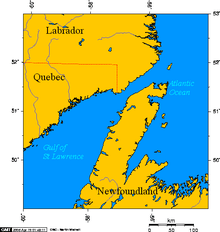Newfoundland-Labrador fixed link
The Newfoundland-Labrador fixed link refers to various proposals for constructing a fixed link consisting of bridges, tunnels, and/or causeways across the Strait of Belle Isle, connecting the province of Newfoundland and Labrador's mainland Labrador region with the island of Newfoundland. This strait has a minimum width of 17.4 km (10.8 mi).
Labrador and Newfoundland are currently connected by ferry service between Blanc-Sablon, Quebec (close to the Labrador border) and Corner Brook. However, the most important ferry connection between Newfoundland and mainland Canada is the Marine Atlantic service between Port-aux-Basques and North Sydney, Nova Scotia, a distance of approximately 165 km (103 mi).


The idea is not new, it was one of Joey Smallwood's ideas in 1949 per The Western Star, Nov 2013. It was again put forward by mining engineer Tom Kierans during the early 1970s as a means to bring hydroelectricity from Churchill Falls to the island part of the province. About $75 million was spent by the provincial government on constructing such a utility tunnel but the project was cancelled in 1975.
The island of Newfoundland is the largest land mass outside the Arctic Islands not directly connected by fixed link to the Canadian mainland. The Confederation Bridge, which connects Prince Edward Island and New Brunswick is about 12.9 km (8.0 mi) long, is significantly shorter than the Newfoundland-Labrador link would be, and crosses the Abegweit Passage, a shallower and calmer body of water than the Strait of Belle Isle.
In the lead-up to the October 2003 provincial election, Progressive Conservative leader Danny Williams promised to fund a feasibility study to placate link supporters.
2004 Feasibility Study
The feasibility study into a Newfoundland-Labrador fixed link, resulting from the 2003 election promise by newly elected premier Danny Williams, was released in 2004. It examined causeway, bridge and tunnel options and recommended that a tunnel beneath the Strait of Belle Isle, accommodating a single railway track, would be the only feasible option, given the area's harsh winter weather conditions, the strait's bathymetry (the depth and shape of the sea floor), and the geology of underlying soils.
Electric-powered trains would be loaded on either side and carry cars, buses and transport trucks. The authors of the study estimated that construction, either by tunnel boring or lowering pre-constructed tunnel sections to a trench in the sea floor, is beyond the current technological limit due to the depth of the sea floor and scouring of the strait by icebergs.
The authors also stated that the cost of construction and low traffic levels would not justify the cost. Conceivably, if built with federal aid, the 1949 terms of union might be amended to remove federal subsidies from the federally operated Marine Atlantic ferry service that connects Port-aux-Basques with North Sydney, Nova Scotia and place them instead on the proposed fixed link.
In terms of driving distance, a fixed link would not be favourable for residents of the Maritimes or parts of the Eastern Seaboard of the United States as they would have to drive to Quebec City where bridges cross the St. Lawrence River (there are ferries further downstream), before continuing east along Quebec's Côte-Nord (of the Gulf of St. Lawrence).
Highway connections
The south coast of Labrador was isolated from the rest of the North American road network until completion of the Trans-Labrador Highway in 2009, and upgrades to its counterpart Route 389. The eventual completion of Route 138 will provide a more direct link between Labrador and the North American road network.
Criticism of the project
Business and community leaders in Newfoundland and Labrador and the rest of Canada have also spoken out against the project, noting that the economic argument for such a link is not proven. The Economist derided the proposal in a story entitled Now let's dig an expensive hole.[1]
See also
References
- ↑ "Now let's dig an expensive hole". The Economist. November 27, 2003. Retrieved July 31, 2013.